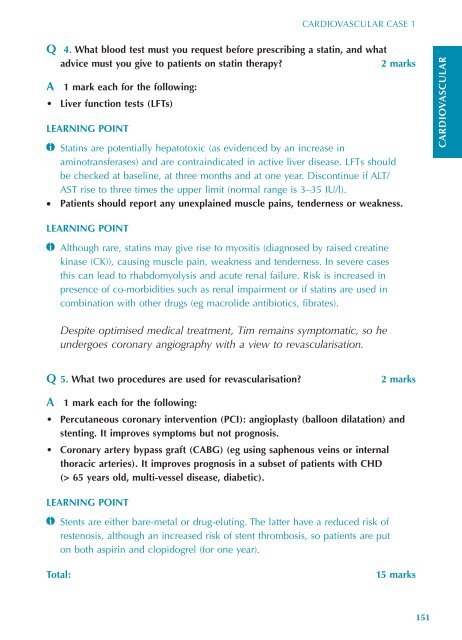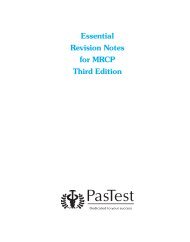Comprehensive Core Clinical Cases Self-Assessment for ... - PasTest
Comprehensive Core Clinical Cases Self-Assessment for ... - PasTest
Comprehensive Core Clinical Cases Self-Assessment for ... - PasTest
- No tags were found...
Create successful ePaper yourself
Turn your PDF publications into a flip-book with our unique Google optimized e-Paper software.
CARDIOVASCULAR CASE 1Q 4. What blood test must you request be<strong>for</strong>e prescribing a statin, and whatadvice must you give to patients on statin therapy?2 marksA 1 mark each <strong>for</strong> the following:Liver function tests (LFTs)LEARNING POINTÜ Statins are potentially hepatotoxic (as evidenced by an increase inaminotransferases) and are contraindicated in active liver disease. LFTs shouldbe checked at baseline, at three months and at one year. Discontinue if ALT/AST rise to three times the upper limit (normal range is 3–35 IU/l). Patients should report any unexplained muscle pains, tenderness or weakness.CARDIOVASCULARLEARNING POINTÜ Although rare, statins may give rise to myositis (diagnosed by raised creatinekinase (CK)), causing muscle pain, weakness and tenderness. In severe casesthis can lead to rhabdomyolysis and acute renal failure. Risk is increased inpresence of co-morbidities such as renal impairment or if statins are used incombination with other drugs (eg macrolide antibiotics, fibrates).Despite optimised medical treatment, Tim remains symptomatic, so heundergoes coronary angiography with a view to revascularisation.Q 5. What two procedures are used <strong>for</strong> revascularisation?2 marksA 1 mark each <strong>for</strong> the following:Percutaneous coronary intervention (PCI): angioplasty (balloon dilatation) andstenting. It improves symptoms but not prognosis.Coronary artery bypass graft (CABG) (eg using saphenous veins or internalthoracic arteries). It improves prognosis in a subset of patients with CHD(> 65 years old, multi-vessel disease, diabetic).LEARNING POINTÜ Stents are either bare-metal or drug-eluting. The latter have a reduced risk ofrestenosis, although an increased risk of stent thrombosis, so patients are puton both aspirin and clopidogrel (<strong>for</strong> one year).Total:15 marks151
















